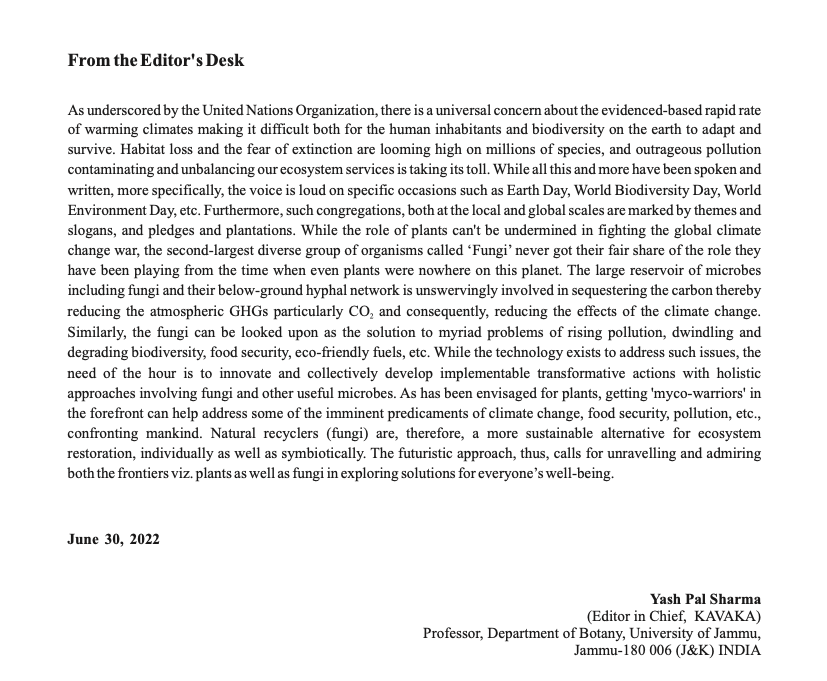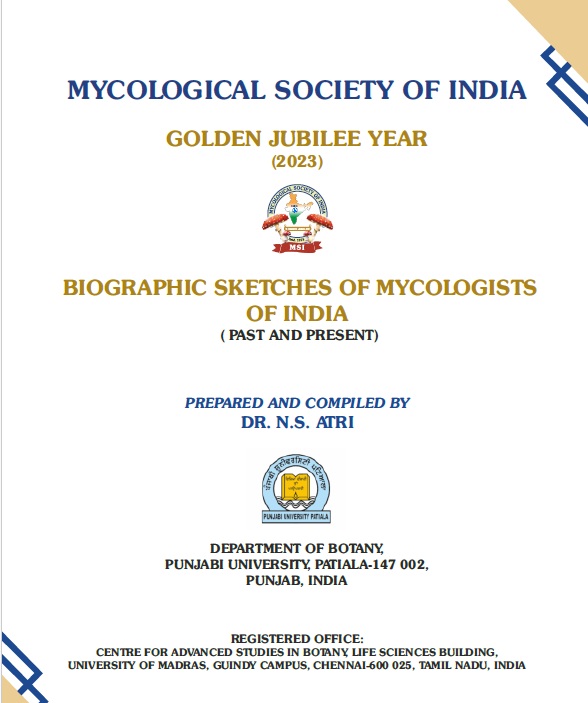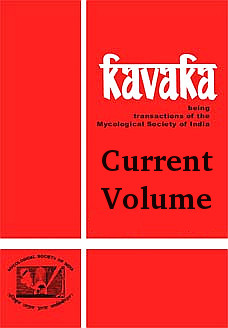
KAVAKA 58 (2): 1-4 (2022)DOI: 10.36460/Kavaka/58/2/2022/1-4
Plant-arbuscular mycorrhizal fungal interaction: Insight into sustainable agroecosystems
B.F. Rodrigues
Department of Botany, Goa University, Goa 403 206, India
Corresponding author Email: This email address is being protected from spambots. You need JavaScript enabled to view it.
Sustainable agriculture is based on the understanding of ecosystem services. It includes environment-friendly methods of farming that allow the production of crops or livestock without damaging human or natural systems. Among the micro-organisms, the arbuscular mycorrhizal (AM) fungi play a vital role in increasing the crop yield without compromising the soil fertility and thus assist in sustainable agriculture. As President of the Mycological Society of India (MSI), I express my deep sense of gratitude to the esteemed members of MSI for their continued efforts over the years to promote the growth of mycology in our country and raise our Society to greater heights in the coming years.
This review focuses on plant-AM fungal interaction as well as provides an insight into sustainable agroecosystems. The rhizosphere microbiome comprises functionally diverse microorganisms ranging from plant pathogens to mutualists. Among the latter are AM fungi, which are considered the most prominent examples of interactions between plants and microorganisms. This plant-AM fungal interaction significantly affects the competence of the host plant's roots to absorb several nutrients, especially phosphorus (P), from the soil. Production and application of AM fungal inoculum are most easily recognized as an AM fungal technology. However, there is a need to determine the mechanism of plant-AM fungal interaction within given socio-economic constraints for the sustainable functioning of agroecosystems.
KAVAKA 58 (2): 5-10 (2022)DOI: 10.36460/Kavaka/58/2/2022/5-10
Antifungal efficacy of mycosynthesized silver-selenide nanoparticles against Aspergillus niger and their antioxidant activity evaluation
Sk Najrul Islam, Sadia Parveen, Syed Mohd Adnan Naqvi, Azam Raza and Absar Ahmad*
Interdisciplinary Nanotechnology Centre (INC), Z. H. College of Engineering and Technology, Aligarh Muslim University, AMU, Aligarh, UP-202 002, India
*Corresponding author Email: This email address is being protected from spambots. You need JavaScript enabled to view it.
(Submitted on March 29, 2022; Accepted on May 18, 2022)
ABSTRACT
The green approaches of nanoparticle synthesis using microorganisms have become a subject of great interest as microbial synthesis is highly reproducible, reliable, cheap, and can be easily up-scaled, resulting in the production of highly stable, water-dispersible nanoparticles in abundant quantities. Recently, our group has synthesized gold selenide (AuSe) nanoparticles (NPs) and studied their antisporulant activity against Aspergillus niger. AuSe NPs inhibit sporulation only, and not the mycelial growth of the fungus. In order to inhibit both, sporulation and mycelial growth of the A. niger, and find a cost-effective alternative to the much more expensive gold raw material, we concentrated our efforts on synthesizing Silver Selenide (Ag2Se) NPs. Herein, the chalcogenide semiconducting Ag2Se NPs have been successfully mycosynthesized through a two-step sequential reaction using the endophytic fungus Fusarium oxysporum. These mycosynthesized Ag2Se NPs with an average particle size of 11 nm have been fully characterized using TEM, XRD, UV-Vis-NIR, FTIR, and Fluorescence Spectrometer, while the optical bandgap energy (2.3 eV) of Ag2Se NPs was determined by the tauc plot method. Additionally, the disc diffusion method tested the antifungal activity of these mycosynthesized NPs, and the spotted inhibition zone across the sterile discs confirmed their antifungal potency against Aspergillus niger. The antioxidant activity of Ag2Se NPs was evaluated using the DPPH scavenging assay with 83.3% scavenging efficiency.
Keywords: Ag2Se NPs, Antifungal, Antioxidant, Endophyte, Mycosynthesis
KAVAKA 58 (2): 11-16 (2022)DOI: 10.36460/Kavaka/58/2/2022/11-16
Characterization of chemical constituents of Coprinopsis cinerea (KX468975), a coprophilous mushroom
S. Mohankumar1* and J. Savitha2
1St. Joseph's College (Autonomous), Langford Road, Shantinagar, Bengaluru- 560027. Karnataka, India
2Department of Microbiology, Biotechnology and Food Technology, Bangalore University, Jnanabharathi campus, Bangalore- 560056, Karnataka, India.
*Corresponding author Email: This email address is being protected from spambots. You need JavaScript enabled to view it.
(Submitted on April 28, 2022; Accepted on June 11, 2022)
ABSTRACT
Exploration of coprophilous mushrooms as a source of biologically active compounds is gaining importance in recent years. The present study was designed to determine the mycochemicals present in the methanolic extracts of fruit bodies and mycelia of coprophilous fungus Coprinopsis cinerea (KX468975) by qualitative methods and evaluation of their volatile components by gas chromatography coupled with mass spectroscopy. The qualitative mycochemical analyses of fruit bodies and mycelia have shown the presence of important chemical constituents such asalkaloids, terpenoids, flavonoids, cardioglycosides, quinones, phenols and tannins. Further, GC-MS analysis of methanolic extracts of fruit bodies and mycelia have led to the identification of 16 types of organic compounds belonging to n-alkanes, 1-alkenes, 1-alkanols, free fatty acids, alkyl esters, saturated and unsaturated fatty acids, sterols, triterpenes, mono and sesquiterpenes, 1-amines, aldehydes and amide groups. This provides baseline information about the bioactive constituents of Coprinopsis cinerea in providing valuable compounds of with significant medicinal values
Keywords: Corpophilous fungus, Coprinopsis cinerea, Methanolic extract, Bioactive compounds, Mycochemicals, GC-MS analysis
KAVAKA 58 (2): 17-21 (2022)DOI: 10.36460/Kavaka/58/2/2022/17-21
First record of Boletus himalayensis (Basidiomycota, Boletaceae) from Kalatop Wildlife Sanctuary, Himachal Pradesh, India
Dyutiparna Chakraborty
Cryptogamic Unit, Central National Herbarium, Botanical Survey of India, 3rd MSO Building DF block, Sector 1, Salt Lake City, Kolkata 700064, India
Corresponding author Email: This email address is being protected from spambots. You need JavaScript enabled to view it.
(Submitted on April 21, 2022; Accepted on June 19, 2022)
ABSTRACT
A member of porcini mushroom was collected from Western Himalayan region of Himachal Pradesh and critical literature survey, taxonomic investigation along with nrITS based phylogenetic analysis establish that this is the first report of Boletus himalayensis from India. A detailed morphological description, illustration, molecular phylogeny and distribution map of the species, along with taxonomic note is given.
Keywords: Macrofungi, nrITS, Phylogeny, Taxonomy
KAVAKA 58 (2): 22-28 (2022)DOI: 10.36460/Kavaka/58/2/2022/22-28
Dematiaceous fungi as etiological agents of superficial mycosis in North India
Bharti Sharma and Skarma Nonzom*
Department of Botany, University of Jammu, Jammu-180006, Jammu and Kashmir, India
*Corresponding author Email: This email address is being protected from spambots. You need JavaScript enabled to view it.
(Submitted on March 11, 2022; Accepted on June 06, 2022)
ABSTRACT
Superficial mycosis are common fungal infections of the skin, hair and nails which are responsible for causing morbidity and cosmetic disfigurement, affecting the patient's quality of life. In addition to dermatophytes, non-dermatophyte molds, which are usually regarded as contaminants are emerging as causal agents of such infections. In the present study, four dematiaceous fungi viz., Alternaria alternata, A. tenuissima, Curvularia brachyspora and Stemphylium sarciniforme were recovered from the human skin specimens. Direct microscopy, cultural, morphological and microscopic characteristics were taken into account for the identification of the recovered fungal causal agents. Of the recovered etiological agents of superficial skin mycosis, Stemphylium sarciniforme represents a new global report, A. tenuissima and Curvularia brachyspora new reports from India and A. alternata is a new report from Jammu and Kashmir.
Keywords: Superficial mycosis, dematiaceous fungi, Alternaria alternata, A. tenuissima, Curvularia brachyspora, Stemphylium sarciniforme
KAVAKA 58 (2): 29-36 (2022)DOI: 10.36460/Kavaka/58/2/2022/29-36
Bioprospecting of fungi from ecological niches of Assam for industrial biomolecules
Pradeep Verma1*, Bikash Kumar1,2, Nisha Bhardwaj1,3 and Ansar Alam1
1Bioprocess and Bioenergy Laboratory, Department of Microbiology, Central University of Rajasthan, Ajmer, 305 817, Rajasthan, India
2Department of Biosciences and Bioengineering, Indian Institute of Technology Guwahati, Surjyamukhi Road, North, Guwahati, 781 039, Assam, India
3Department of Chemical Engineering, Institute of Chemical Technology, Nathalal Parekh Marg, Matunga, Mumbai, Maharashtra, 400 019, India
*Corresponding author Email: This email address is being protected from spambots. You need JavaScript enabled to view it.
(Submitted on April 11, 2022; Accepted on May 25, 2022)
ABSTRACT
Assam is situated in the northeast region of India and is unexplored for its fungal diversity. Fungi are capable of utilizing waste materials as their substrates. In order to do so, their metabolism is designed so that they generate several biomolecules of great value to humans. The climate and biomass availability in Assam provide optimal nutrient and environment for the growth of a wide variety of fungus. In the present study, soil and decaying leaf samples were collected from tea gardens, vegetable and rice fields located in the Cachar District of Assam. These samples were screened for fungal isolates on potato dextrose agar medium. A total of thirty-six (36) fungal isolates were obtained. The morphological and phenotypic characterization of these isolated fungal strains were performed and the majority of fungal isolates were identified from genus Aspergillus, Penicillium, Rhizopus, Schizophyllum, Trichoderma, etc. The isolated strains were screened for their antagonistic properties and four (4) isolate showed antagonist properties against Aspergillus suggesting its antifungal potential. Also, the isolated strains were subjected to qualitative plate assays for their enzyme production abilities critical for biorefinery industries such as xylanase, cellulase, and amylase. The isolates LC1 and COC showed high xylanase and cellulase activity, respectively. These high cellulases and xylanase-producing isolates were identified as Aspergillus oryzae (LC1) and Schizophyllum commune (COC) through molecular identification. These isolates were subjected to enhanced enzyme production and subjecting them to several biorefinery applications for the production of biofuel and value-added compounds (oligosaccharides). Similarly, the inherited properties of other isolates can be used for different industrial applications to solve the problem of mankind.
Keywords: Fungi, Bioprospecting, Biomolecules, Enzymes, Industrial applications, Assam
KAVAKA 58 (2): 37-52 (2022)DOI: 10.36460/Kavaka/58/2/2022/37-52
Fungal L-asparaginases- A mini review
Anil Kumar Meghavarnam1, Ruchi Sahu2 and Savitha Janakiraman2*
1Department of Life Science, Bangalore University-560056, Bangalore, Karnataka, India
2Department of Microbiology and Biotechnology, Bangalore University-560056, Bangalore, Karnataka, India
*Corresponding author Email: This email address is being protected from spambots. You need JavaScript enabled to view it.
(Submitted on April 02, 2022; Accepted on June 13, 2022)
ABSTRACT
L-asparaginase is an enzyme that catalyzes the hydrolysis of L-asparagine to L-aspartic acid and ammonia. These enzymes are mainly produced by microbes. Microbial L-asparaginase has received much importance in the field of medicine for treating leukemia particularly acute lymphoblastic leukemia (ALL). This enzyme is also used extensively in food industries for reducing the formation of acrylamide in starch-based foods. In this review we focus on the recent developments in the production (submerged and solid-state fermentation), purification and applications of fungal L-asparaginases in medicine and acrylamide mitigation. Additional research is however required for exploring novel fungal L-asparaginase for confirming their potentiality in leukemia treatment and acrylamide mitigation.
Keywords: Fungi, Fermentation, L-asparaginase, Leukemia, Acrylamide
KAVAKA 58 (2): 53-56 (2022)DOI: 10.36460/Kavaka/58/2/2022/53-56
Synthesis and characterization of ZnO nanoparticles using Pleurotus florida extract
Kumar Manimaran1,2 and Subban Murugesan2*
1Department of Chemical Engineering, Sri Sivasubramaniya Nadar College of Engineering, Kalavakkam, Chennai- 603110, Tamil Nadu, India.
2Department of Botany, School of Life Sciences, Periyar University, Periyar Palkalai Nagar, Salem-636 011, Tamil Nadu, India
*Corresponding author Email: This email address is being protected from spambots. You need JavaScript enabled to view it.
(Submitted on March 03, 2022; Accepted on May 29, 2022)
ABSTRACT
In recent years, eco-friendly, simple, cost-effective synthesis of nanoparticles through green method is developing interest in the modern research. In this present work, the ZnO nanoparticle (ZnO NPs) was synthesized by the facile green process using Pleurotus florida extract. The structure, morphology, size, elemental properties of the synthesized ZnO NPs were characterized by UV visible spectroscopy, X-ray diffraction, Fourier transform infrared (FT-IR) spectra, scanning electron microscope (SEM), transmission electron microscope (TEM) analyses. The XRD pattern show pure crystalline nature of the ZnO NPs and spherical shape morphology of NPs was noted by SEM image. The broad spectrum of antibacterial activity was observed in both gram-positive and gram-negative bacteria and maximum growth inhibitory zone was recorded in Klebsiella pneumoniae (14.36±0.41 mm) and Bacillus cereus (14.12±0.41 mm) followed by other tested organisms. Based on the findings of present study the biosynthesized ZnO NPs from P. florida can be served as an alternative, eco-friendly nano medicine in the near future.
Keywords: Pleurotus florida, Biosynthesis, ZnO NPs, Antibacterial activity
KAVAKA 58 (2): 57-65 (2022)DOI: 10.36460/Kavaka/58/2/2022/57-65
Biosynthesis of fluorescent cadmium sulfide nanoparticles using neem endophytic fungus and evaluation of their anti-proliferative and anti-microbial activities
Ejaz Ahmad Siddiqui1, Rashmi Sharma1, Asad Syed1, Shadab Khan1, Ravindra Taware1, Sk Najrul Islam3, Mahesh Kharat2, Kalpana Pai2, Narendra Kadoo1, Vidya Gupta1 and Absar Ahmad*1,3
1Division of Biochemical Sciences, CSIR-National Chemical Laboratory, Pune - 411 008, India
2Department of Zoology, Savitribai Phule Pune University, Pune - 411 007, India.
3Interdisciplinary Nanotechnolcogy Centre (INC), Z.H. College of Engineering and Technology, Aligarh Muslim University, AMU, Aligarh, UP - 202 002, India.
*Corresponding author Email: This email address is being protected from spambots. You need JavaScript enabled to view it.
(Submitted on March 28, 2022; Accepted on June 11, 2022)
ABSTRACT
In the present manuscript, we demonstrate a reliable and eco-conscious approach for the fabrication of technologically important cadmium sulfide (CdS) nanoparticles using neem (Azadirachta indica) fungal endophyte, later identified as Fusarium oxysporum based on cultural and morphological characteristics. A 10-3 M aqueous solution of precursor salt cadmium sulfate (CdSO4) when reacted with endophytic fungus resulted in the bio-construction of copious amounts of well dispersed CdS nanoparticles of 10-40 nm with an average 20 nm size. These bio-constructed CdS NPs were characterized by standard analytical techniques like UV-Visible spectroscopy (UV-Vis), Fourier Transform Infrared Spectroscopy (FTIR), Fluorescence Spectroscopy (FS), X-ray diffraction (XRD), Transmission Electron Microscopy (TEM), Selected Area Electron Diffraction (SAED) and Energy Dispersive Analysis of X-rays (EDAX). Cytotoxic activity of these nanoparticles was checked against three different cell types viz. human breast cancer (ZR-75-1), Daudi (Human Burkitt's lymphoma) and normal human peripheral blood mononuclear cells (PBMC) where our CdS nanoparticles proved anti-proliferative against cancer cells but safe toward normal cells. Moreover, toxicity assessment toward human RBC revealed less than 0.1 % hemolysis as compared to Triton X-100, thus implying safe nature of our biosynthesized CdS nanoparticles on human cells. Also, our nanoparticles exhibited significant anti-fungal (against Aspergillus niger) and anti-bacterial [against Gram positive (Bacillus subtilis and Staphylococcus aureus) and Gram negative (Pseudomonas aeruginosa)] bacteria activity thus suggesting their good potential to be developed as novel therapeutic agents. The present investigation opens up avenues for eco-friendly and reliable fluorescent nanomaterials to be used in a wide variety of application such as in vivo imaging, cell labeling, cell tracking, drug delivery and so on.
Keywords: Anti-microbial, Anti-proliferation, Cytotoxicity, CdS nanoparticles, Endophyte, Fusarium oxysporum
KAVAKA 58 (2): 66-72 (2022)DOI: 10.36460/Kavaka/58/2/2022/66-72
Medicinal mushrooms of Kerala - a brief overview
K.B.Vrinda
Formerly, Mushroom Research Lab, Jawaharlal Nehru Tropical Botanic Garden & Research Institute, Palode, Thiruvananthapuram 695 562, Kerala, India.
Corresponding author Email: This email address is being protected from spambots. You need JavaScript enabled to view it.
(Submitted on January 29, 2022; Accepted on May 04, 2022)
ABSTRACT
Kerala is rich in its fungal biota. Mushrooms indigenous to Kerala have enormous potential as sources of bioactive agents for biopharmaceutical exploitation. A study which aimed to bring out a comprehensive account of the wide variety of medicinal mushrooms available in Kerala, revealed the presence of 34 species of medicinal mushrooms. Ecological survey, molecular identification and assessment of the medicinal potentials of these mushrooms are good research domain. This will ensure the full and sustainable exploitation of these mushrooms
Keywords: Kerala, Medicinal properties, Mushrooms
KAVAKA 58 (2): 73-81 (2022)DOI: 10.36460/Kavaka/58/2/2022/73-81
Metagenomic analysis of active ectomycorrhizal zone of Astraeus using cloud computing approach from two seasons
Vineet Vishal1,2, Geetanjali Singh1 and Shalini Lal1*
1Department of Botany, Dr Shyama Prasad Mukherjee University, Ranchi- 834008, Jharkhand
2Department of Botany, Bangabasi Evening College, Calcutta University, Kolkata-700009, West Bengal
*Corresponding author Email: This email address is being protected from spambots. You need JavaScript enabled to view it.
(Submitted on May 04, 2022; Accepted on June 16, 2022)
ABSTRACT
Ectomycorrhizosphere is a hub where plant roots and soil microorganisms actively interact (ectomycorrhizal fungi and bacteria). However, the mechanisms that regulate interactions between mycorrhizal fungi, soil bacteria, and plant roots are poorly understood. Here we use a cloud-based computing approach for the identification, diversity and functional roles of hidden uncultured microbial communities around the active ectomycorrhizal zone of wild edible mushroom of Astraeus from dry deciduous Sal Forest of Jharkhand, India by targeting 16S rRNA gene amplicons. The soil samples were collected during the monsoon (July) and winter (November) seasons of 2021. The monsoon and winter ectomycorrhizosphere were found to have a high richness of 161 and 251 Operational Taxonomic Units (OTUs) at a >97% sequence identity. These two environments have markedly different bacterial community compositions. Across the seasons Proteobacteria, Acidobacteria, Actinobacteria and Nitrospirota were significantly abundant phylum, surprisingly in winter, the ectomycorrhizosphere had fewer Firmicutes, Bacteroidota and a higher Verruco-microbiota taxon. Sugar metabolism, amino acid metabolism, metabolism of cofactors and vitamins was the most abundant functional category in the ectomycorrhizosphere. The Alphaproteobacteria and Gammaproteobacteria were the most abundant classes of bacterial communities in the active ectomycorrhizal zone. Thus, the presence of nitrogen-fixing and phosphate-solubilizing bacteria in the ectomycorrhizosphere soil may influence the plant-fungus symbiosis' functioning.
Keywords: Astraeus, Ectomycorrhizosphere, Nephele, Metagenomics, PICRUSt























